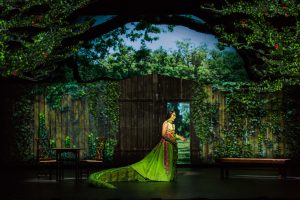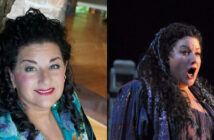OPERA REVIEW: The Ouroboros Trilogy (Naga; Madame White Snake; Gilgamesh)
INTERVIEW: Cerise Lim Jacobs
Caution: There are snakes on this immortal plane!
The universe according to librettist/mythmaker Cerise Lim Jacobs is a treacherous, beautiful reptilian playground where serpent-demons shapeshift, meddle with humanity, instigate epic battles and hanker after love. It’s a coil of a cosmos, and we get to tour its every whiplash curve in Jacobs’ magnificent and extravagant new operatic magnum opus, The Ouroboros Trilogy, which debuted in a day-long performance marathon at Boston’s Emerson/Cutler Majestic Theater on Saturday, September 10, 2016 (co-produced by the dauntless and cutting-edge Beth Morrison, and the resourcefully cultivated funding consortium, “Friends of Madame White Snake”).
Put a Ring on It
The “ouroboros” of the title – so delicious, mystical, incantatory a word – is the Greek term for the image of a snake consuming its own tail, forming a seamless “O.” Carl Jung ranked it as one of humanity’s innate and essential psychological archetypes, suggestive of renewal, reincarnation, and eternity. Jacobs seizes it like the brass ring of a whirling carousel, then rolls out its symbolism and implications to dizzying and intoxicating effect.
Indeed, the ouroboros might be said to be Cerise Lim Jacobs’ answer to Wagner’s ring of the Nibelung. Not since the latter’s Ring Cycle has quite so total an act of operatic mythmaking been elaborated by a single poet’s imagination. The Ouroboros Trilogy’s three installments (Jacobs conceived and wrote all three libretti, while each opera has a different composer) track across centuries, wrap around the brain and sink theatrical fangs deep in the psyche.
Dead Ringer
“I love Wagner,” Jacobs avers. “Although,” she adds with a chuckle, “I do sometimes wish he had had a good editor!”
Still, says Jacobs, “He was so brilliant, he could get away with five- and six-hour works.”
Jacobs embraces a somewhat stricter economy. “I follow the Alfred Hitchcock mantra,” she says. “100 minutes, no intermission.’” And, indeed, along with rich texts and plenary plot twists, each opera clocks in at or under that fleet running time.
Gods and Monsters (and the Rest of Us Folk… )
Opera I, entitled Naga, kicks off with a dazzling choral conspectus of snake mythology drawn from a host of cultures – Chinese, Vedic, biblical – with hefty helpings of creation myth and trans-cultural flood stories folded in for good measure. The cumulative effect is compelling and transformative – an audience conversion experience in which, by sheer dint of powerful poetry and music, we cede to a view of the cosmos as essentially snake-driven!
Having thus tutored us, Jacobs gets down to cases.
The Naga (or divine serpent) of the title – and the protagonist of the entire trilogy – is “The White Snake” (a well-known fairytale figure in Chinese culture). Formerly a powerful woman warrior, she has been transformed into an immortal snake-demon as payback for prior mortal wickedness. And to complicate matters, she has been followed into immortality by her one-time human servant, Xiao Qing, who in human life had been desperately in love with her. Unfortunately, Xiao Qing has been whacked with a problematic supernatural whammy of his own: along with passage into immortality (as a green snake demon), he has also undergone a surprise gender-bending, and is now consigned to an eternity as the White Snake’s sisterly comrade, locked in a state of perpetually thwarted desire (this racy element is one of Jacobs’ many proprietary innovations on the ancient tale).
Hiss and Hers
From this provocative premise, the first opera unfolds as a sort of interspecies love quadrangle: White Snake hopelessly besotted by a young mortal monk whom she pursues relentlessly; young monk fixed only on achieving nirvana and thus abandoning his own young wife for a life of solitary quest; Green Snake jealously and futilely pining for White Snake; young wife grappling with both a secret pregnancy, and a host of abandonment issues.
Watch Your Back
It all comes to a head in the White Snake’s encounter with the opera’s fifth principal – the “Master” – a figure who will reincarnate in both of the other two operas, stalking the White Snake through the eons as her unflappable nemesis – a sort of resurgent Van Helsing to the White Snake as vampire.
Have You Met Myth Jacobs?
“I came to the operatic form later in life,” says Jacobs – by way, in fact, of her husband Charles’ enthusiasm.
“I got dragged right into the midst of it,” she says. “And I realized that the form was particularly suited to creating myths. One was able to play with time – enlarge time, compress time, range from past to present. Time is so fluid in opera – and it works much the same way as myth, which always operates simultaneously in the past, present, and future.”
It’s an apt insight for transiting into The Ouroboros Trilogy’s centerpiece – the opera titled Madame White Snake (which was actually written prior to and independently of the other two installments that now bookend it, premiering in 2010 and subsequently winning a Pulitzer Prize for its composer, Zhou Long).
Gimme Some Love
In Madame White Snake, we encounter the lady in a different, initially more sympathetic, even poignant light. Less predatory, she is now questing for an experience of authentic human love, and is mysteriously granted a kind of divine existential reprieve, becoming transformed for a time back into human form, and meeting a mortal man (who may be a reincarnation of the Monk of Naga) who takes her as his wife.
The ever-spurned Green Snake grumbles, of course, but it’s the reappearance of the Master that again triggers havoc. With his shattering of the serpent’s connubial nest, cataclysmic and hair-raising warfare rains down on humanity.
Sons and Lovers
In the trilogy’s final installment, Gilgamesh, Jacobs makes a surprise side-wind into Near Eastern mythology. The focus here is primarily on the character of Ming – the half human, half demon offspring of the White Snake and her husband from the previous opera. By canny narrative prestidigitation, Jacobs manages to conflate Ming with aspects of the ancient Gilgamesh myth and draw us toward a chilling dénouement in his encounter with his mother. The White Snake’s final emergence in this opera – and our dawning awareness of what has been wrought in her by centuries of iniquitous reincarnation – are both profound and shocking.
Snake Charmers

Susannah Biller (White Snake) and Michael Maniaci (Xiao Qing/Green Snake) in Madame White Snake, Photo: James Daniel
The three distinctive and sophisticated musical approaches by the trilogy’s three composers are a wonderful gift of variety. Naga’s score, by composer Scott Wheeler, offers a rich array of stylistic references. There are hymn motifs, soaring sublimities, aural landscape painting, and pastoral passages reminiscent of William Walton and Benjamin Britten. Wheeler’s vocal profile for the White Snake also features thrilling and ingenious neo-Mozartian flights of coloratura, like modernist reimaginings of the Queen of the Night.
“Scott Wheeler is an amazing craftsman,” says Jacobs. “He’s an architect as well as a composer, and he structures his music the way you would design a building.”
The Pulitzer-Prize winning score to Madame White Snake, by Zhou Long, offers the richest synthesis of diverse elements. His vocal lines feature uncannily death-defying leaps and dips derived from the praxis of the Peking Opera. He also delivers exotic instrumentations (tams, bells, aboriginal rainsticks) and unprecedented choral effects (group chirrups, dry little snake tongue flittings, keyless group moans that sound as mournful as souls frozen in Sheol).
By contrast, though, there are passages of exquisite romantic luxury. Jacobs’ own favorite aria (“I call it ‘The Awakening Aria’”) in which the White Snake first appreciates her humanness – the warmth of her skin and blood in contrast to her prior snake soma – is set by Long with a shimmering, gentle sensuality worthy of a Debussy or Poulenc.
Finally, Paola Prestini’s score for Gilgamesh is perhaps the most easily assimilable to late romantic Western operatic practice. “The music feels to me like a flowing river,” says Jacobs; and, indeed, the sustained and ethereal arcs of many phrases are remarkable. Yet Prestini also pulls out a good number of highly driven, Boulez-like episodes that torpedo us toward the opera’s final, appropriately enigmatic culminating tableau.
The performers are all highly effective and fully committed to the monumentality and expansiveness of the narrative. Each opera has its own separate cast of principals. Hence, we are treated to triple interpretations of each recurring character.
In each cast, it appears by design that voices were chosen for their warmth of tone, with the exception of the White Snake herself, who is properly distinguished in each opera by the brightness and occasional otherworldliness of her soprano sound.
Stacey Tappan, the White Snake of Naga, was agile and fearless, and characterized her demon by turns as pert, mischievous and downright malevolent. Susannah Biller, the titular Madame White Snake of the central opera, evinced gleaming purity of tone while presenting a protagonist grown into full awareness of the glamour, seductiveness and enigma of her reclaimed mortality. Hila Plitmann, the White Snake of Gilgamesh, emitted gorgeously and eerily spun filaments of sound which matched the sly, sinuous, dangerously denatured creature her character has become by epic’s end.
The young men of each opera were, respectively, baritone Matthew Worth (rich-voiced, intense, and brooding), tenor Peter Tantsits (who performed feats of magic with Zhou Long’s incredibly demanding vocal writing, ranging from the very upper reaches of fair-play tenor territory to depths that were frankly subharmonic), and baritone Christopher Burchett (lithe, commanding, and heroic).
The figure of the “Master” was played successively by bass-baritones David Salsberry Fry, Dong-Jian Gong and Andrew Nolen, all ideally austere and sable-voiced.
The two performers who play the green snake Xiao Qing are so uncannily effective and persuasive as the long-suffering, glittering, green female halfling that it almost seems a shame to dispel mystery and disclose that they are men. These remarkable artists are: countertenor Anthony Roth Costanzo (the only performer to do service in two separate casts), and male soprano Michael Maniaci.
Rounding out the principals are mezzo-soprano Sandra Piques Eddy, moving and sultry voiced as the Monk’s wife in Naga; and soprano Heather Buck, whose pure and versatile vocalism brought just the right poignancy to the role of the tragic wife in Gilgamesh.
Each opera features a double chorus – one composed of professional adults, one drawn from the Boston Children’s Chorus – who were ranged effectively along both sides of the theater’s audience space in novel, quasi-oratorio-like fashion.
The exquisite clarity with which the three scores were rendered is high tribute to accomplished conductors Carolyn Kuan, Lan Shui, and Julian Wachner.
What a World
The Ouroboros Trilogy satisfies on many levels. And Cerise Lim Jacobs chose extremely wisely in putting the entire staging and production design under the direction of visionary Michael Counts.
“I chose Michael because I had seen the last production he did at New York City Opera – Rossini’s Moses in Egypt,” says Jacobs. “I told him how impressed I was by his use of a big LED screen, so he knew exactly what I wanted. And he delivered 100 times more than I could have imagined.”
The technological ingenuity and sophistication – not to mention sheer imagination – of Counts’ design cannot be overstated. Our sense of proportion and perspective is constantly toyed with. Scenes are sometimes viewed both straight on and, simultaneously, in pre-filmed sequences, from above. At other times, a character is seen at one and the same time in full view on the stage as well as enlarged to mammoth proportions on the screen behind him or her.
Scenic elements are projected in gem-like high-definition – glittering garden groves with blossoms that writhe in eerie slow-motion vegetable life; soaring bridges and vertiginous Himalayan mountain passes; corpse-strewn flood waters; apocalyptic landscapes riven by Miltonic cracks of thunder and Doomsday javelins of lightning.
And, perhaps most memorably, there is the recurrence of a massive White Snake avatar which slithers throughout the universe, sometimes traversing Star-Trek like fields of nebuli, sometimes receding sinisterly into a distant black emptiness, and at one point seeming to lunge directly forward from the rear of the stage to devour not only the opera cast but the entire audience in its gaping maw. Blackout!
Shedding Her Skin
Jacobs writes rich and resonant sententiae. There is indeed a mythic power to her sensibility, covert beneath the level of the literal. And her life story is itself an epic: born in Singapore, expatriating with her family from communist China to a new life in Australia. From there it was Great Britain, and eventually the U.S., specifically Boston. She is retired from a practice as an attorney and is now a full-time story-teller par excellence. Her next project, slated by producer Beth Morrison for a 2018 premiere, is PermaDeath, which Jacobs says was inspired by her son’s (and now her own) interest in online gaming and which she describes as “the first interactive video-game opera.”
Time is of the Essence
What most seizes one in the experience of Jacobs’ trilogy is the notion of time – its preciousness, its scarcity, its clarifying demands. Ultimately, gods are pitied in The Ouroboros Trilogy, and only mortals can claim the treasured wisdom that comes with the certainty of finality. “More time, more time / We mortals moan for more time / Vainly clutching our children’s shadows / We stand still as time races by.”
Remarkably, there are no current explicit plans to move The Ouroboros Trilogy elsewhere, nor to produce it again. Hopefully, that will change. Still, like most precious things in life, this work’s beauty may be inseparable in some respects from the brevity of its existence.
Remaining performances are: Gilgamesh, September 14, 2016 (7:30 PM); Naga, September 15, 2016 (7:30 PM); Gilgamesh, September 17, 2016 (11:00 AM); Naga, September 17, 2016 (3:00 PM); and Madame White Snake, September 17, 2016 (07:30 PM). ArtsEmerson.org; (617) 824-8400.
















